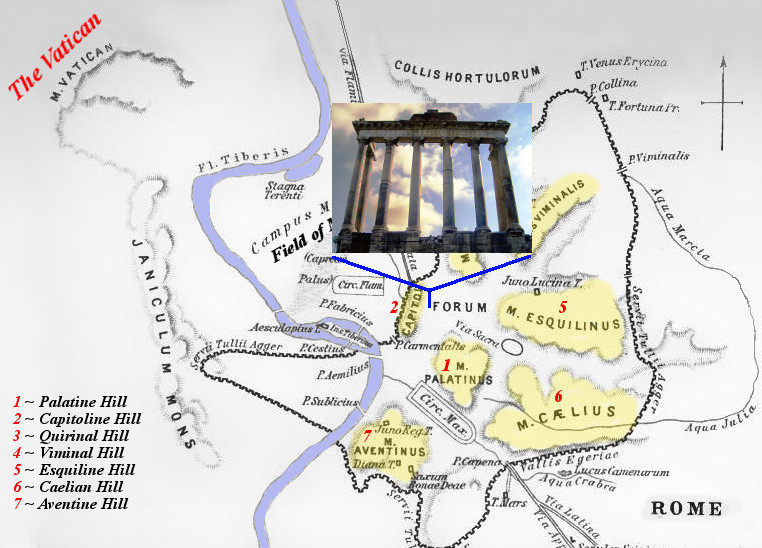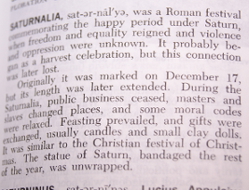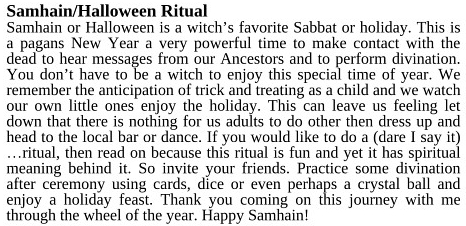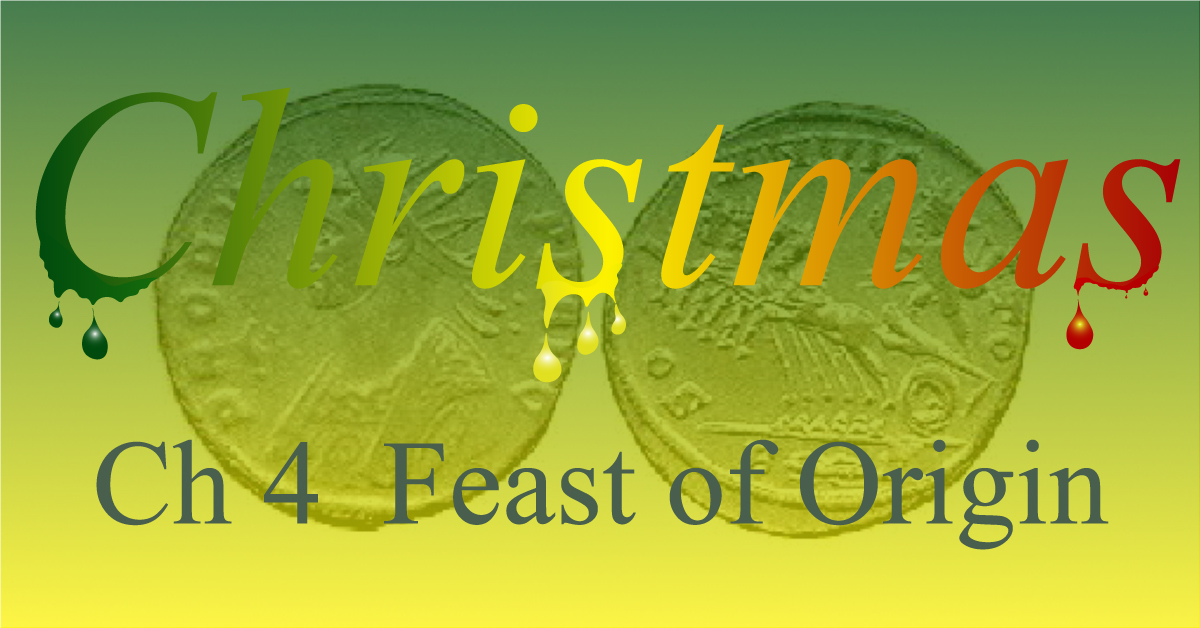The Feasts of Origin
All widely observed Christmas traditions and rituals are of pagan origin.
The Natalis Sol Invicti is now referred to by the Christian name Christmas. Did the holiday take on a new Christian nature, or is it still celebrated pretty much the way it always has been? According to all serious studies of paganism, the exact meaning behind pagan customs, rituals, and traditions has always changed over time as new influences from different cultures combined. Therefore, the meaning of each ritual or custom can mean one thing at one point in time and something different at another point in time. This is the case with the rituals and traditions surrounding Christmas as well. As we will see, all widely observed Christmas traditions and rituals are of pagan origin. Some, but not all, of these rituals and traditions were developed to worship Baal or the sun.
We have seen how the date of Christmas is connected to the Natalis Sol Invictus (birthday of the unconquered sun). Now we will see how the rituals and traditions surrounding Christmas can be traced back to three main pagan feasts. Those feasts are the Saturnalia (honoring Saturn), the Kalends (New Year), and Samhain (more commonly known as Halloween). The rituals and traditions surrounding Christmas were brought into the church at Rome when it was busy trying to convert pagans to Christianity. We will begin looking at the specific Christmas traditions in the next chapter. But first, here is a short overview of each of the three pagan holidays from which most of the traditions surrounding Christmas are derived.
Saturnalia
Every December as the most popular holiday of the year approaches, the kids look forward to a few days out of school. Excitement fills the air, and the hustle and bustle of everyday life increases as the majority of society prepares for the coming holiday. There is a small minority who view the holiday as a dreaded time of the year. They will spend their time largely isolated from society until the revelries die down. Most people, however, look forward to traditions like kissing under mistletoe, drinking eggnog, lighting candles, giving gifts, and a holiday ham. Many will don a pointed felt hat for this holiday. This is a hat they would not normally wear at any other time of the year. It is also customary at this holiday for employers to give their employees a little extra bonus money. When the holiday finally arrives, most shops and government offices are closed, and the kids will receive toys as gifts. What holiday is it? It is a holiday known as saturnalia. Yes, this is an accurate description of how pagans once celebrated a holiday in honor of their pagan god Saturn. Does this sound a lot like how Christmas is celebrated in the U.S.A. today?
The Saturnalia and its associated traditions are very old. The writings of both Cicero and Livy can be used to confirm the Saturnalia predates the coming of Christ and any early Christian celebrations. The Roman historian Livy tells us the Saturnalia was instituted in 495 B.C. (Livius "vol. 1" 141). Marcus Tullius Cicero was a Roman statesman who died on December 7, 43 B.C. about four decades before Christ was born (Cicero & Middleton, pp. 1, 291). However, Cicero mentioned the Saturnalia in his personal letters and other writings (Cicero & Middleton, pp. 161, 215, 683, 792). These facts combine to demonstrate the Saturnalia was an ongoing part of Roman life for well over four centuries before Christ was born. Therefore, any notion pagans may have copied early Christian Christmas celebrations can be factually discounted on multiple counts. The order of events clearly shows Christmas celebrations borrowed from the Saturnalia rather than the Saturnalia borrowing from Christmas.

We can learn more about how this holiday became connected to Christmas by going back to the Chronography of 354. On the same page of the calendar which we looked at earlier for the month of December, we will find a holiday called Saturnalia on the 17th day of the month. I have highlighted it in this image.
The Saturnalia was celebrated in honor of the pagan god Saturn. Therefore, we should learn a little about this pagan deity. This will help us understand certain aspects of the traditions and customs developed in his honor. Here is a short description.
This description of Saturn tells us he was the god of agriculture who was responsible for bringing the people a Golden Age which was a period of peace, happiness, and prosperity. The Saturnalia was held in his honor and was meant to be a reminder of this Golden Age; it was a reenactment of the period of peace, happiness, and prosperity which Saturn was credited with giving the people. By now, we may begin to see some basic similarities between Christmas and Saturnalia. These similarities will become much clearer as we continue.

This map shows the location of Saturn’s temple in Rome. The remains of the temple of Saturn are still a very prominent landmark in Rome.
The following definition of Saturnalia comes from my 1991 copy of the Encyclopedia Americana International Edition.

| Similarities | Saturnalia | Christmas |
|---|---|---|
| Religious holiday | ✔ | ✔ |
| Celebrated in December | ✔ | ✔ |
| Gifts exchanged | ✔ | ✔ |
| Parties | ✔ | ✔ |
| Best of days/Favorite time of year | ✔ | ✔ |
| Major holiday of the year | ✔ | ✔ |
| Most Businesses Closed | ✔ | ✔ |
| Government offices closed | ✔ | ✔ |
| Children out of school | ✔ | ✔ |
| A time of peace/goodwill | ✔ | ✔ |
| Indulgence/Feasting | ✔ | ✔ |
| Candles/lights | ✔ | ✔ |
| Poor elevated | ✔ | ✔ |
This definition tells us the Saturnalia "was similar to the Christian festival of Christmas." How similar is Christmas to Saturnalia? We will get in to the specifics in future chapters, but here is a chart showing a partial list of the similarities so far.
This is an appropriate time to look at the type of traditions observed at the Saturnalia. Some of these customs were not bad things. The portrayal of peace and goodwill towards others can hardly be seen as a bad thing. The uplifting of the poor and downtrodden is an admirable trait. In fact, if we isolate each of these traditions, we would be hard pressed to find fault with many of them. Only when we compare the numerous commonalities as a whole, do we start to frame the image. Then, when we realize all of these similarities are acted out on the anniversary of the day set aside by the pagans, the true nature of the picture starts to come into focus. If we are in search of the truth, the numerous similarities between these holidays must, at the very least, be cause for further investigation. We are only beginning. The similarities shown in this chart represent only a small sampling of the similarities which the traditions of Christmas hold in common with pagan rituals.
Why is there such a similarity between the way Christmas and Saturnalia are celebrated? To get the answer to this question, we need only recall why the connection was made between Christ and Sol — the church in Rome was attempting to convert pagans to Christianity. The Roman church was unsuccessful in its attempts to get the pagans to walk away from their pagan holidays, so they attempted to Christianize those pagan holidays. The following quote from Mr. Nissenbaum explains the situation very well.
The fact we see many Christians complaining Christ is being removed from Christmas is witness to the fact Mr. Nissenbaum's words are accurate. Christmas is an extremely difficult holiday to Christianize, and the Christian hold on Christmas is as tenuous as ever. Every year numerous lawsuits are brought in an attempt to keep Christ out of Christmas by the secular world. All the while, Christians are crying out "Keep Christ in Christmas!" The secular world does not object to Christmas. It objects to Christ. The secular world joins hand-in-hand with Christians in setting up Christmas trees, decorating with lights, telling their children of Santa, and even charity. Secularist only object to the manger scenes and anything else which remotely associates Christmas with Christ. This alone should give Christians reason to question the origin of Christmas traditions. Now we will take a look at the next main holiday Christmas is modeled after: The ancient Roman holiday known as Kalends or New Year.
The Kalends

The London Encyclopaedia defines the Kalends as a solemn festival consecrated to Juno and Janus. It states the Romans sacrificed to these gods and also gave each other presents (Tegg 297). If we think this sounds a little like the way the Saturnalia was celebrated, we are not alone. Those who have dedicated their studies to these holidays see the similarities also, as we can witness in the following encyclopedia quote.
These descriptions sound very similar to how Christmas and the New Year are celebrated in the United States today. This next quote will provide a unique opportunity for us to peer through a window which opens onto the streets of the fourth century Roman Empire at the time of the Kalends celebration. The quote is from a fourth century Greek Sophist named Libanius.
This quote seems to capture the spirit of the Kalends as it glides in perfect harmony with the spirit of Christmas across the vacuum of time. One could hardly notice nearly two thousand years separate the celebration described by Libanius from what we witness every year here in America. Some of the traditions associated with the Kalends appear to bring out the best in humanity. Christmas also sometimes entices some to help their fellow man more than normal. This is well and good. However, we must not forget the Kalends was, at its heart, a method for paying homage to pagan gods. Libanius ends his Oration IX on the Kalends with the following lamentation because the law of his time prohibited the customary sacrifices during the Kalends.
Mr. Wright surmises the cessation of sacrifices mentioned here was the result of the edict of Theodosius I in 391 which closed all the pagan temples and forbade pagan sacrifice. Libanius apparently witnessed sacrifices at the Kalends because he also described them in his Progymnasmata, The Exercise in Description 5: New Year.
| Similarities | Kalends | Christmas |
|---|---|---|
| Religious holiday | ✔ | ✔ |
| Major holiday of the year | ✔ | ✔ |
| Celebrated at end of year | ✔ | ✔ |
| Gifts exchanged | ✔ | ✔ |
| Decorating homes with greenery | ✔ | ✔ |
| Decorating homes with lights | ✔ | ✔ |
| Feasting | ✔ | ✔ |
| Parties | ✔ | ✔ |
| Impulse to spend | ✔ | ✔ |
| Spend yearly savings | ✔ | ✔ |
| Children out of school | ✔ | ✔ |
| Generosity abounds | ✔ | ✔ |
There are numerous accounts describing how the Kalends was celebrated in ancient Rome, and all of the accounts are very similar; there seems to be little disagreement on the methods of celebration. Rather than continue quoting several sources, I will paraphrase the description of the Kalends given on pages 19-20 of the book Texts and Studies, Contributions to Biblical and Patristic Literature vol. VIII no. 2 (Robinson, J. Armitage). According to this book which appears to be in harmony with most accounts, the annual Kalends was kept as a day of public rejoicing. The Roman consuls took office on this day and went to the Capitol to offer a sacrifice of white bullocks. The day as well as the month were dedicated to Janus, who was the pagan god of new beginnings. People engaged in superstitious rituals in an attempt to secure prosperity during the coming year. In addition, everyone exchanged gifts and wished each other happiness in the New Year. The Syrians of Antioch were said to celebrate the Kalends by lighting great bonfires, and people from all over Europe and the Middle East greeted their pagan god Janus at daybreak. The book also quotes an article about the persistence of the feast of Kalendae under different names. In that quote, the Kalends is described as follows: "The great festival of Mithra worship, the Mithrakana, which celebrated the rebirth of the Sun (natalis Invicti), was observed at this time, the conclusion of the winter solstice." The book goes on to quote other works which state "all heathens celebrate the feast." The feast spoken of here is, of course, the Kalends of January.
Christmas has always been an extremely difficult holiday to Christianize.
It is important to note the use of fire and lights in the celebration of the Kalends is widely reported. This particular book focuses on the building of bonfires, but the use of candles and smaller fires are prolific throughout writings about the rituals associated with the Kalends. The lighting of candles and fires was said to be symbolic of the re-birth of the sun after the winter Solstice which occurred on or about the 25th of December. The winter solstice will be discussed more thoroughly in the section dealing with candles and lights.
This book mentions the persistence of the holiday under different names. This is a common theme which is repeated time after time throughout the history of paganism. The holidays take on new names, and new meanings are attached to the rituals, but the rituals themselves remain virtually unchanged. This ability of the ritual to transcend time is again evident in the striking similarity between the way Christmas and the Kalends are observed. We will now look at one more pagan holiday which lends some of its rituals to the observance of Christmas.
Samhain
The Samhain is an ancient Celtic festival marking the beginning of winter which is now commonly called Halloween.
This definition from the Collins English Dictionary tells us Samhain marked the beginning of the Celtic New Year. We need to recognize the New Year referenced here actually fell at the beginning of November and should not be confused with the New Year which is currently observed on January 1.
The vast majority of the rituals associated with the Samhain are descended directly to Halloween, but there are a couple of rituals which have also made the leap over to Christmas.

These specific rituals are not nearly as universally recognized as those from the Saturnalia and Kalends and are generally observed in very specific geographical locations. However, this is worth mentioning here because it helps demonstrate the ability of a pagan ritual to leap across the calendar and take on a new name while still retaining its essence.
Halloween is one of those celebrations which leaves no doubt as to its pagan connection and origin. The names Halloween and Samhain are used interchangeably, in some circles, as we see in this quote from the book titled Walking the Path (Laboucane "Samhain"). The holiday is still commonly celebrated by those who admittedly and openly practice paganism.
The book Wicca for Men is a modern book for men who practice witchcraft. It was first printed in 1998. Here we see it places Samhain on the 31st of October which is obviously known as Halloween. This same book also identifies the Samhain as the Celtic New Year.
The book goes on to say Samhain carries with it the traditions which are more commonly associated with the New Year's celebrations of January 1st. This is not technically correct. At the risk of delving into a discussion resembling the argument about whether the chicken preceded the egg, I want to point out the fact it is the current New Year's celebration which resembles the Samhain celebration not the other way around. Chapter 11 of The Mediaeval Stage by Edmund Kerchever Chambers, describes how the transfer of rituals from the fall to the winter took place. Chambers actually holds the establishment of Christmas partially responsible for the shift in dates (Chambers 234). When the transfer from fall to winter took place, the celebration also took on a new name called Mother's Night.
The transfer from Samhain to Mother's Night was certainly complete by the time of Bede, who lived from 673 to 735 A.D. as we can see in this quote where he states Christmas and Mother's Night were held on the same date (Bede and Faith Wallis 53).
(Bede and Faith Wallis 53).
Bede seemed to be under the impression the celebration of Mother's Night was a thing of the past. I cannot say whether the practice had ceased and has now been revived or whether the celebrations have been continuous, but one thing is certain — the rituals of Mother's Night are now practiced among self-professed pagans of today as we will see in the next quote.
This quote is from the very recent book titled To Walk a Pagan Path which was first printed in 2013. This quote also mentions the yule which is the main ritual the Samhain has transferred to Christmas by way of Mother's Night.
The worship of our Savior is again mingled with pagan feast days dedicated to Baal.
This has been a brief look at the individual feast days from which most Christmas traditions were born. Feast days are mentioned quite frequently in the Bible, and they can be a good thing. In fact, God instituted certain feast days as the Bible tells us. However, the people of God have often tried to co-mingle the worship of God with the rituals of paganism in these feasts. The word of God makes abundantly clear this is unacceptable. The following verses were written in reference to feast days which God Himself instituted.
Amo 5:21 I hate, I despise your feast days, and I will not smell in your solemn assemblies.
Amo 5:22 Though ye offer me burnt offerings and your meat offerings, I will not accept them: neither will I regard the peace offerings of your fat beasts.
Amo 5:23 Take thou away from me the noise of thy songs; for I will not hear the melody of thy viols.
Amo 5:24 But let judgment run down as waters, and righteousness as a mighty stream.
Amo 5:25 Have ye offered unto me sacrifices and offerings in the wilderness forty years, O house of Israel?
Amo 5:26 But ye have borne the tabernacle of your Moloch and Chiun your images, the star of your god, which ye made to yourselves.
God came to hate the very feast days He had instituted because the people had incorporated Moloch, Chiun (Baal idol), and a star into their religious practices. Modern Christmas tradition now duplicates this exact same scenario. The worship of our Savior is again mingled with pagan feast days dedicated to Baal and involves the very same rituals, including the star which tops many Christmas trees at this time of year. We will look more in depth at the star in a later section.
We have touched on the three main holidays which have shaped the rituals of Christmas. We have also seen how the date for Christmas was chosen. Now we will look at the season as a whole.
The Holiday Season
Today we experience a merging of the fall and winter holidays into one long celebratory season which culminates on certain days. We may be under the impression this is a relatively modern turn of events. It does certainly seem the decorations for Christmas in retail establishments go up earlier and earlier each year. The phenomenon of a celebratory season, however, is nothing new.
Nearly two thousand years later, we are still witness to a holiday season which culminates on the 25th of December and the 1st of January.
The celebration of the Saturnalia, which began on the 17th of December, was tied to Sol Invictus, which was celebrated on the 25th of December, and also to the Kalends, in which celebrations officially began on the 1st of January. The celebration of these pagan holidays mingled to form a holiday season. This holiday season contained specific high days on which the celebrations culminated. These days were the 17th of December (Saturnalia), the 25th of December (Sol Invictus) and the 1st of January (Kalends). Some sources state the 17th of December was merely the beginning of the Saturnalia and there were celebratory climaxes reached at the Sol Invictus on the 25th of December and at the Kalends on January 1st. Nearly two thousand years later, we are still witness to a holiday season which culminates on the 25th of December and the 1st of January. Could this possibly be by chance alone, or is Mr. Miles correct when he states "mankind's instinctive paganism is insuppressible" (Miles 26)? The celebratory season, at least in the U.S., now begins before Halloween as is evident by the appearance of Christmas decorations in the stores and on homes. I am writing this particular paragraph on the 16th day of November and I have already seen several homes decorated for Christmas. In respect to the lengthening of the holiday season, modern society has exceeded the limits of pagan antiquity. If history is any indication, the pagan indulgence surrounding this holiday will only strengthen as time continues.
The feast days we have looked at are the foundation upon which the Christmas season is built. These feast days were designed to honor pagan deities which were incapable of performing any deed. Therefore, Satan inspired fables in the minds of men to boast for these pagan gods. For example, the so-called Golden Age under Saturn is clearly nothing more than a fable. Our God is a living God who is capable. Therefore, we need not follow after fables.
2Pe 1:16 For we have not followed cunningly devised fables, when we made known unto you the power and coming of our Lord Jesus Christ, but were eyewitnesses of his majesty.
2Pe 1:17 For he received from God the Father honour and glory, when there came such a voice to him from the excellent glory, This is my beloved Son, in whom I am well pleased.
Now what need have we of cunningly devised fables to worship our Savior? Is the truth not grander than the fables which abound? Why should we mix the worship of God with the fables devised by Satan himself? Our Savior is too good for that. Our God is grander than all of the pagan deities combined. Therefore, the celebrations which were devised to worship those idols are inferior. Not one of those pagan idols could cause one grain of sand to be moved, yet our Creator was not only able to make the sand but was also able to form us from it. How then should we incorporate our living God into the feast given in honor of such worthless fables? To what benefit do we lower our standards to incorporate paganism into our lives? We do not need a pagan holiday to worship our God. We do not need a pagan holiday as an excuse to preach the gospel to the unbelieving. There are certainly some who may be more willing to hear the gospel at this time of year. If they need the pagan holiday to be willing to hear the Word of God, so be it. However, we need not partake in one ounce of the pagan traditions in order to take advantage of the opportunity to proclaim the gospel to them. If we help them build their faith on the foundation of pagan fables, how will they stand when the winds blow and the waves roar?
The Origin of the Rituals and Traditions
We have now examined the main pagan feasts from which Christmas gets its date and rituals. We have also seen how Christmas shares several characteristics with those feasts.
1. Christmas is a main holiday of the year like the Saturnalia and the Kalends.
2. Christmas is a religious holiday like the Saturnalia, Kalends, and Samhain.
3. Christmas is celebrated at the same time of year as the Saturnalia and the Kalends.
4. Christmas is celebrated as a season with culminations on specific days like the Samhain, Saturnalia, and Kalends.
5. Christmas customs entail the closing of government offices, businesses, and schools like the Saturnalia and the Kalends.
6. All widely observed Christmas traditions and rituals are of pagan origin.
7. Historians state "Christmas has always been an extremely difficult holiday to Christianize."
8. Christmas is an example of the worship of our Savior being mingled with pagan feast days dedicated to Baal.
Now we will take an in-depth look at many of the rituals and traditions which are associated with Christmas. All widely observed Christmas traditions are rooted in paganism. I will cover those most commonly observed in the United States. There are so many rituals and traditions associated with Christmas, difficulty arises in knowing where to begin. We will simply start at the top, the top of the head, that is.








